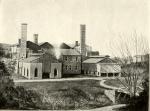| |
| |
|
|
|
| |
| |
FORGING THE FUTURE --
THE BLACKSMITH
William Williams must
have been our area's first blacksmith. Entries
dated to 1744 on his account pages within
Nicholas Dupui's general store ledger show
purchases "To 101 weight of Iron" and "To 170
weight of Iron".
As to what type of goods were manufactured by a
blacksmith, we have a striking testimonial
offered by the commander of local Fort Hydshaw,
Captain John Van Etten, who in his journal
reports:
"May the 7th, 1757. The men call to their
Exercise at the usual time, after which I went
w'th 4 men to a Smiths shop whare we made an
Instrument to take a Bullit out of my Horse, who
was shot when Ser't. Den was Kill'd, and all
return'd safe to the fort."
Yet the craft of blacksmithing wasn't restricted
to the efforts of a single individual.
Apparently, it was a common enough occupation
(as indicated by another entry in the account
page of William McNab, also dated to 1744): "By
Sundry Smith work done to the Sum of £2:8:9".
Later, in the 1780s, we see the role of
blacksmith assumed by John Starr; his account
shows payment to Dupui's store tendered by way
of "shaving plow irons & setting 2 horse shoes,"
and by "iron work of 2 pair of harness".
The ledger reports a number of items that could
have been made by such smiths; a few examples:
-- "to a Crowbar weight 25
lbs."
-- "a Sleigh shod
with iron"
-- "By 5 Days
making plows and other work"
-- "By shaving plow irons &
setting 2 horse shoes"
| As
to the source of the iron, one notes
that the Durham iron furnace (about some
forty miles downriver), dates from the
year 1727. The weekly capacity of the
furnace was twenty-five tons. |
|
 |
|
|
| |
|
|
|
|
|
| |
|
|
|
| |
|
|
|
| |
|
|
| |
|
|
|
|